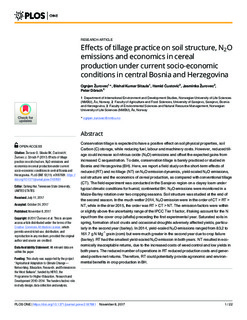| dc.contributor.author | Žurovec, Ognjen | |
| dc.contributor.author | Sitaula, Bishal K. | |
| dc.contributor.author | Čustović, Hamid | |
| dc.contributor.author | Žurovec, Jasminka | |
| dc.contributor.author | Dörsch, Peter | |
| dc.date.accessioned | 2017-12-07T09:35:44Z | |
| dc.date.available | 2017-12-07T09:35:44Z | |
| dc.date.created | 2017-11-23T11:54:52Z | |
| dc.date.issued | 2017 | |
| dc.identifier.issn | 1932-6203 | |
| dc.identifier.uri | http://hdl.handle.net/11250/2469511 | |
| dc.description.abstract | Conservation tillage is expected to have a positive effect on soil physical properties, soil Carbon (C) storage, while reducing fuel, labour and machinery costs. However, reduced tillage could increase soil nitrous oxide (N2O) emissions and offset the expected gains from increased C sequestration. To date, conservation tillage is barely practiced or studied in Bosnia and Herzegovina (BH). Here, we report a field study on the short-term effects of reduced (RT) and no tillage (NT) on N2O emission dynamics, yield-scaled N2O emissions, soil structure and the economics of cereal production, as compared with conventional tillage (CT). The field experiment was conducted in the Sarajevo region on a clayey loam under typical climatic conditions for humid, continental BH. N2O emissions were monitored in a Maize-Barley rotation over two cropping seasons. Soil structure was studied at the end of the second season. In the much wetter 2014, N2O emission were in the order of CT > RT > NT, while in the drier 2015, the order was RT > CT > NT. The emission factors were within or slightly above the uncertainty range of the IPCC Tier 1 factor, if taking account for the N input from the cover crop (alfalfa) preceding the first experimental year. Saturated soils in spring, formation of soil crusts and occasional droughts adversely affected yields, particularly in the second year (barley). In 2014, yield-scaled N2O emissions ranged from 83.2 to 161.7 g N Mg-1 grain (corn) but were much greater in the second year due to crop failure (barley). RT had the smallest yield-scaled N2O emission in both years. NT resulted in economically inacceptable returns, due to the increased costs of weed control and low yields in both years. The reduced number of operations in RT reduced production costs and generated positive net returns. Therefore, RT could potentially provide agronomic and environmental benefits in crop production in BH. | nb_NO |
| dc.language.iso | eng | nb_NO |
| dc.relation.uri | http://journals.plos.org/plosone/article?id=10.1371/journal.pone.0187681 | |
| dc.rights | Attribution-NonCommercial-NoDerivatives 4.0 Internasjonal | * |
| dc.rights.uri | http://creativecommons.org/licenses/by-nc-nd/4.0/deed.no | * |
| dc.subject | Bærekraftig landbruk | nb_NO |
| dc.subject | Sustainable farming | nb_NO |
| dc.subject | Nitrogentap | nb_NO |
| dc.subject | Nitrogen loss | nb_NO |
| dc.title | Effects of tillage practice on soil structure, N2O emissions and economics in cereal production under current socio-economic conditions in central Bosnia and Herzegovina | nb_NO |
| dc.type | Journal article | nb_NO |
| dc.type | Peer reviewed | nb_NO |
| dc.description.version | publishedVersion | nb_NO |
| dc.subject.nsi | VDP::Jordfag: 913 | nb_NO |
| dc.subject.nsi | VDP::Soil sciences: 913 | nb_NO |
| dc.source.volume | 12 | nb_NO |
| dc.source.journal | PLoS ONE | nb_NO |
| dc.source.issue | 11 | nb_NO |
| dc.identifier.doi | https://doi.org/10.1371/journal.pone.0187681 | |
| dc.identifier.cristin | 1517606 | |
| dc.relation.project | Utenriksdepartementet: HERD/Agriculture | nb_NO |
| cristin.unitcode | 192,13,1,0 | |
| cristin.unitcode | 192,14,0,0 | |
| cristin.unitname | Institutt for internasjonale miljø- og utviklingsstudier | |
| cristin.unitname | Miljøvitenskap og naturforvaltning | |
| cristin.ispublished | true | |
| cristin.fulltext | original | |
| cristin.qualitycode | 1 | |

